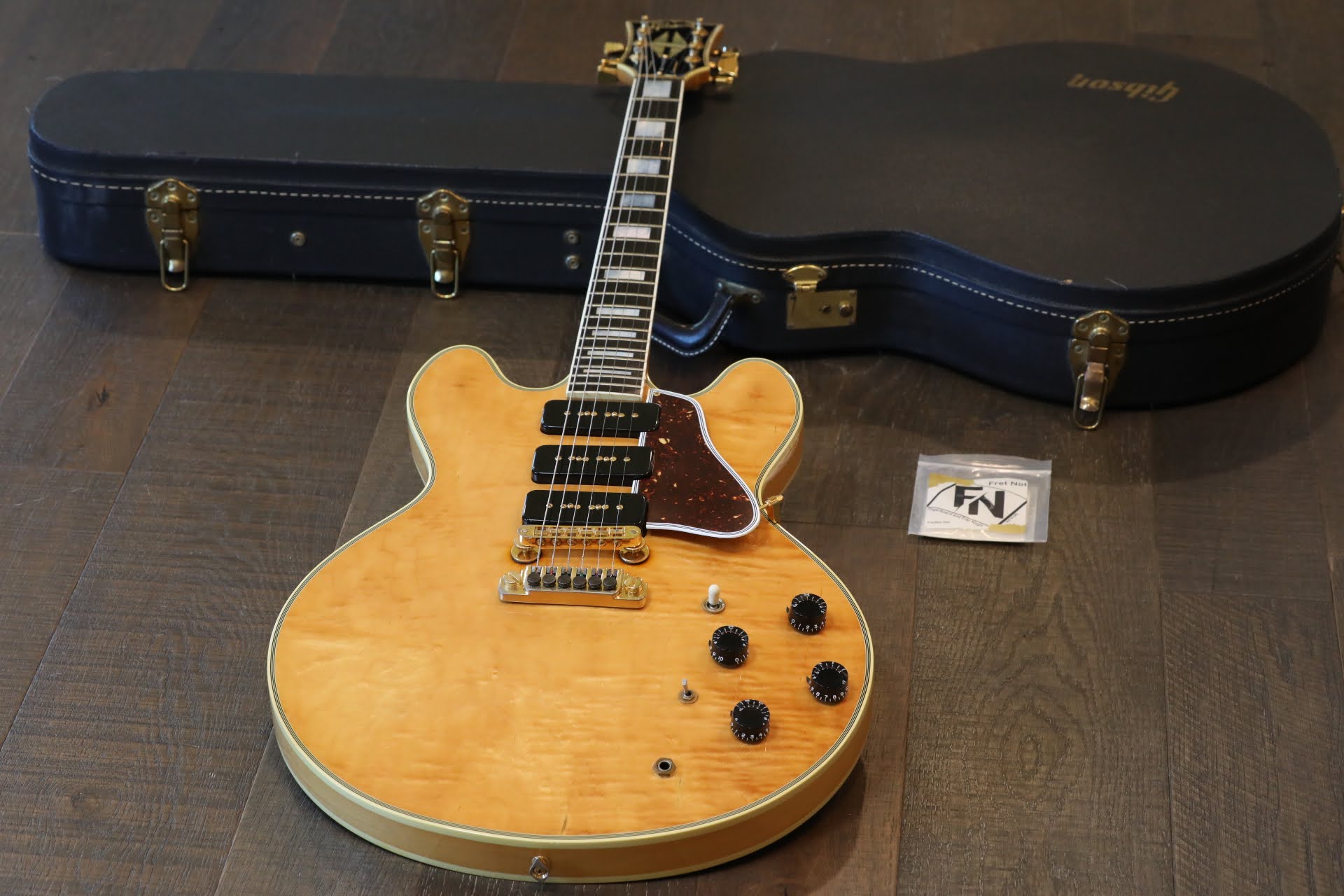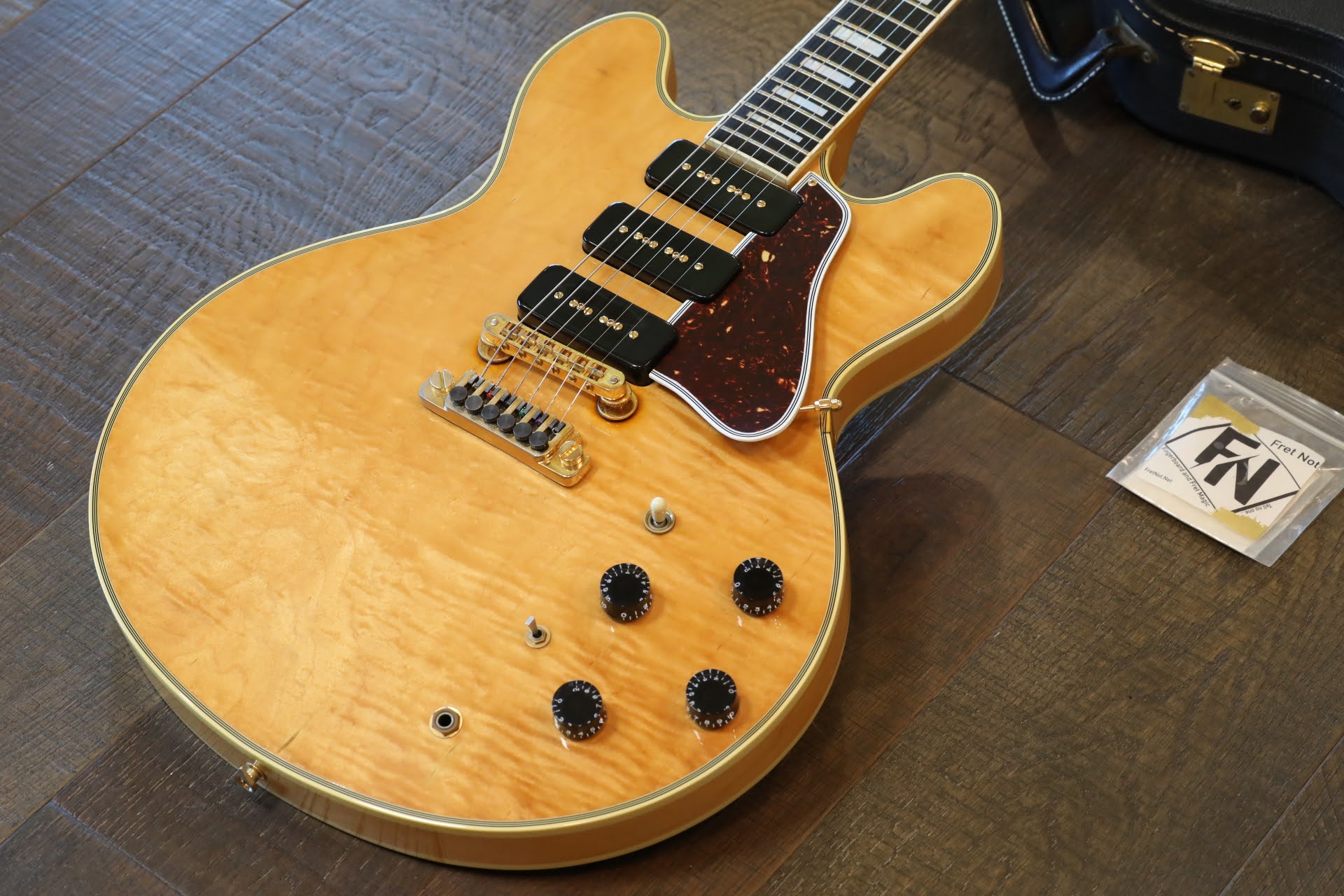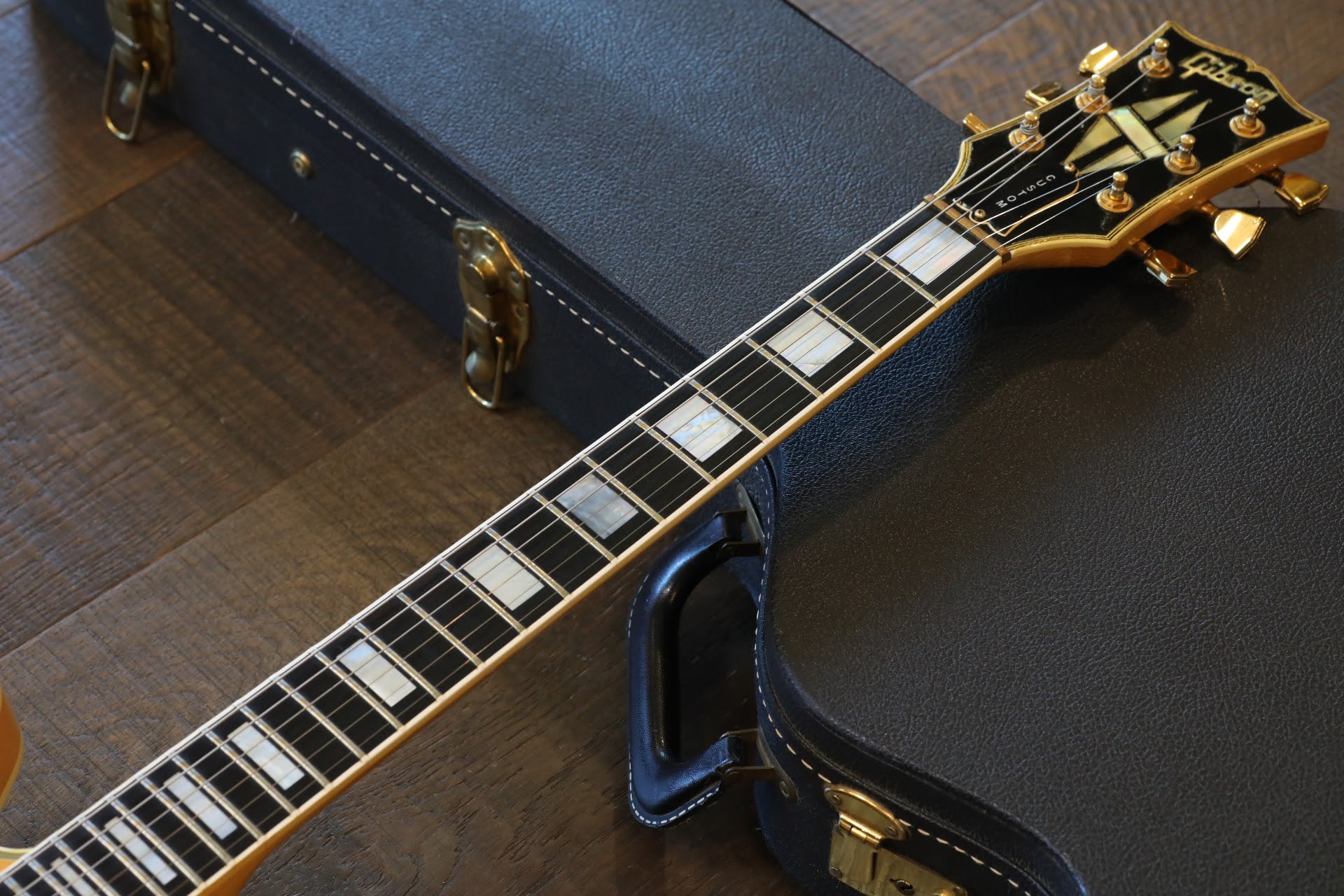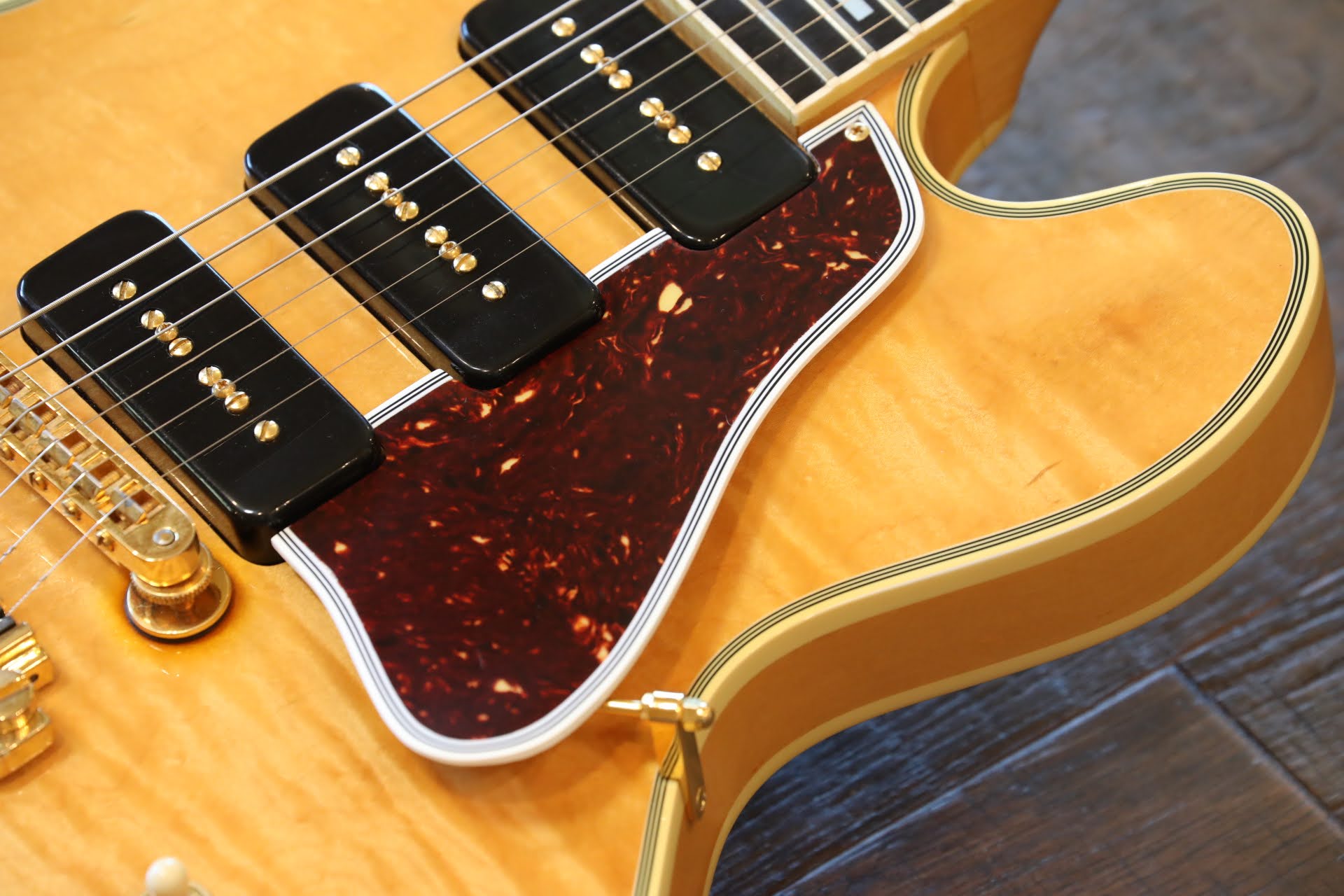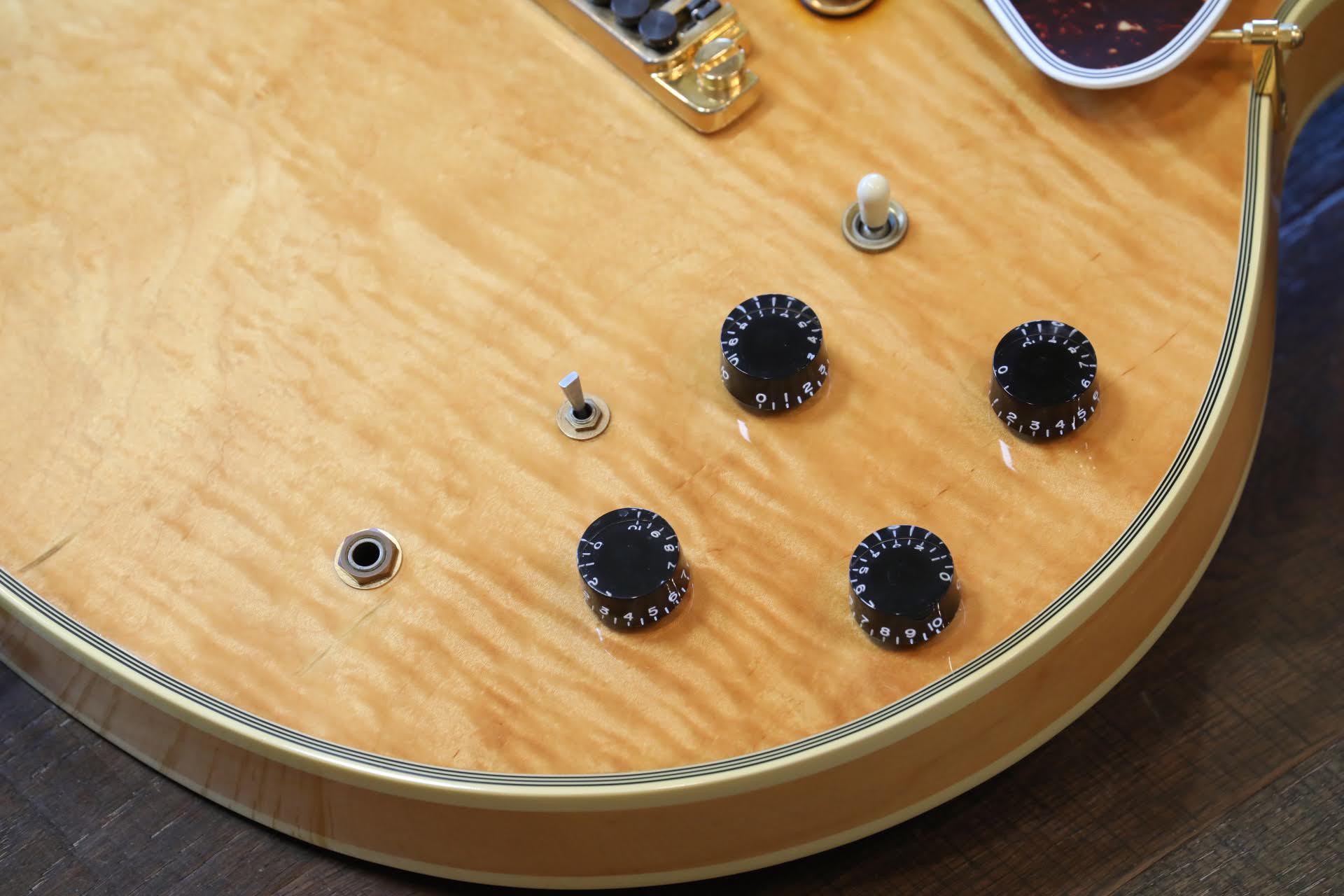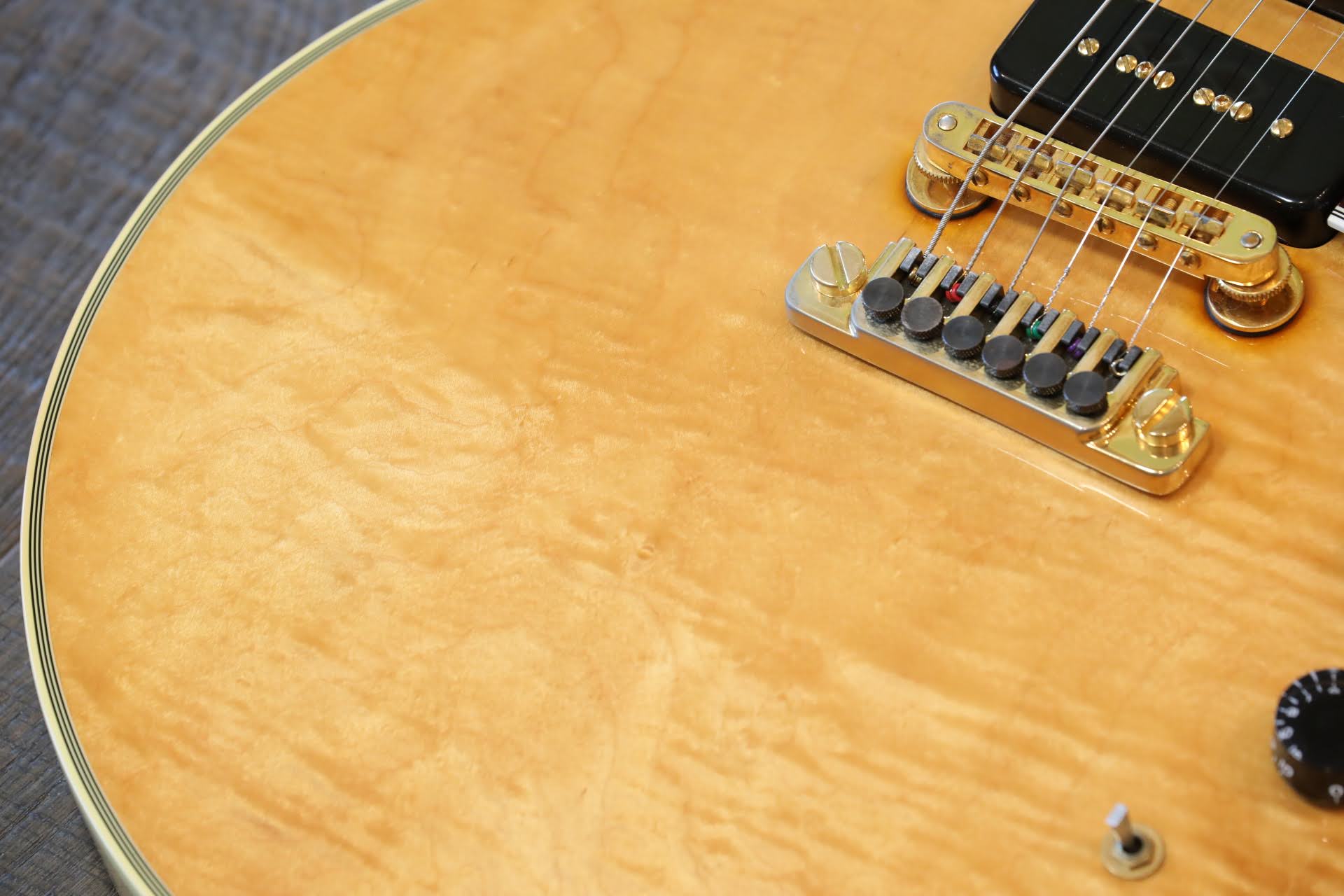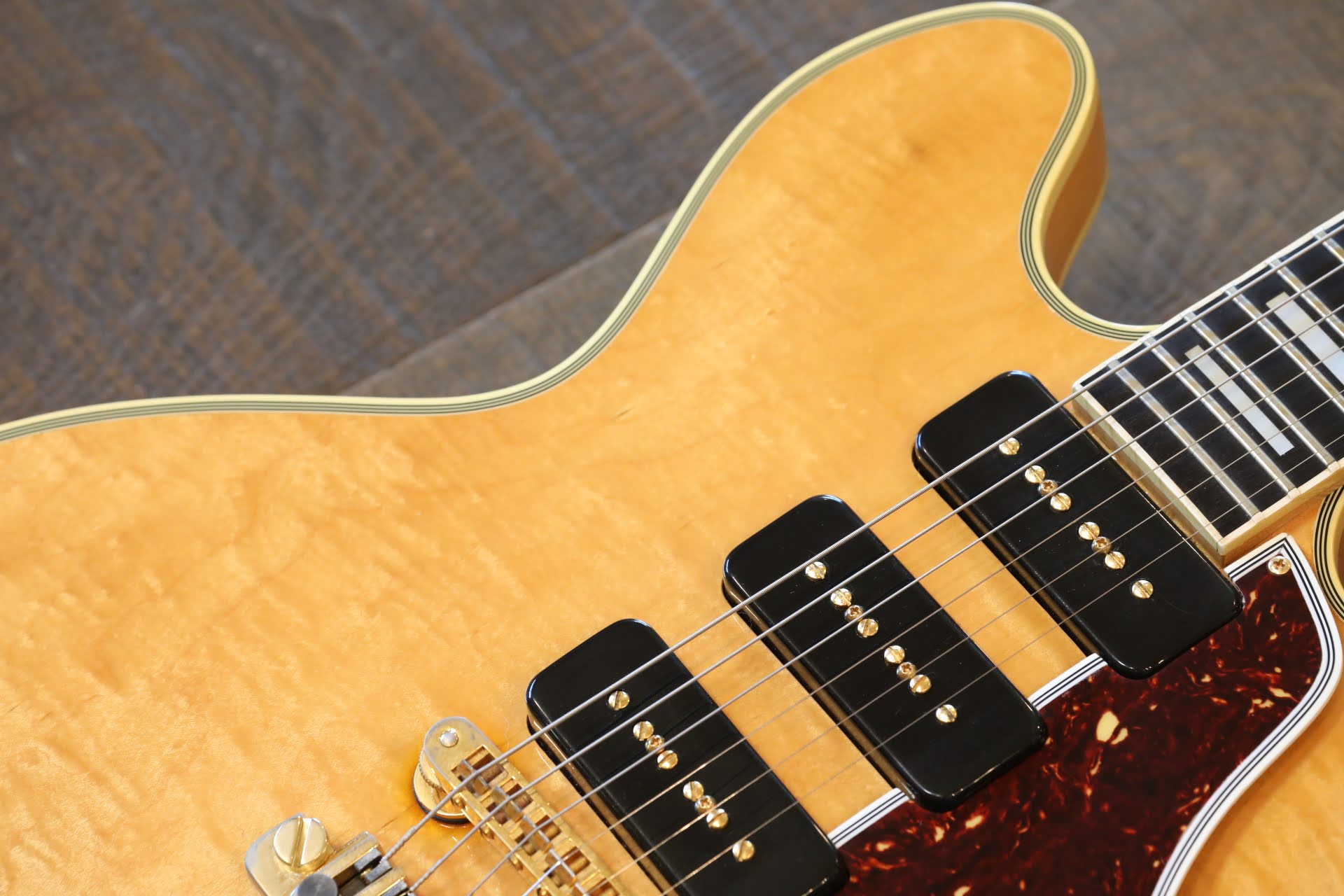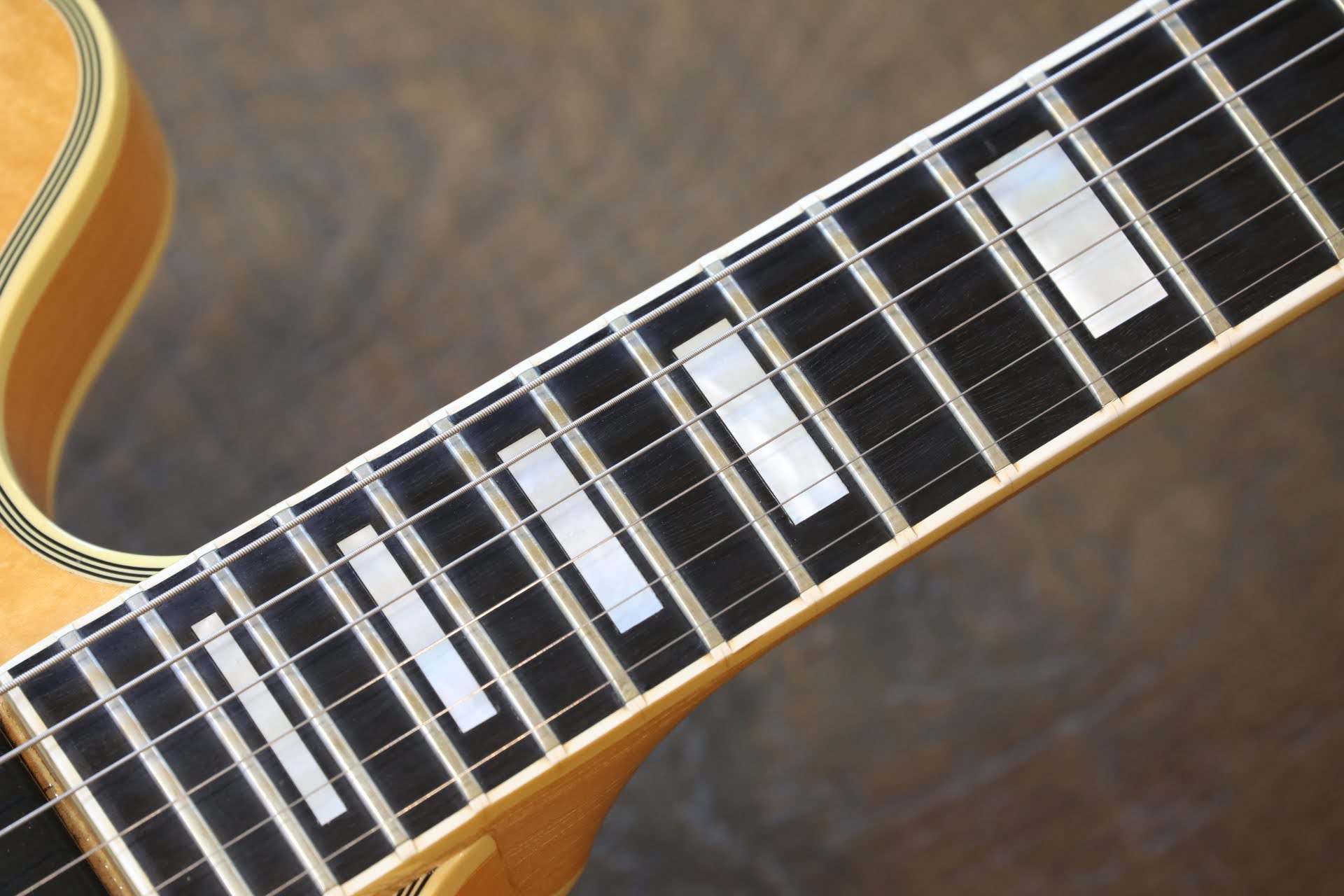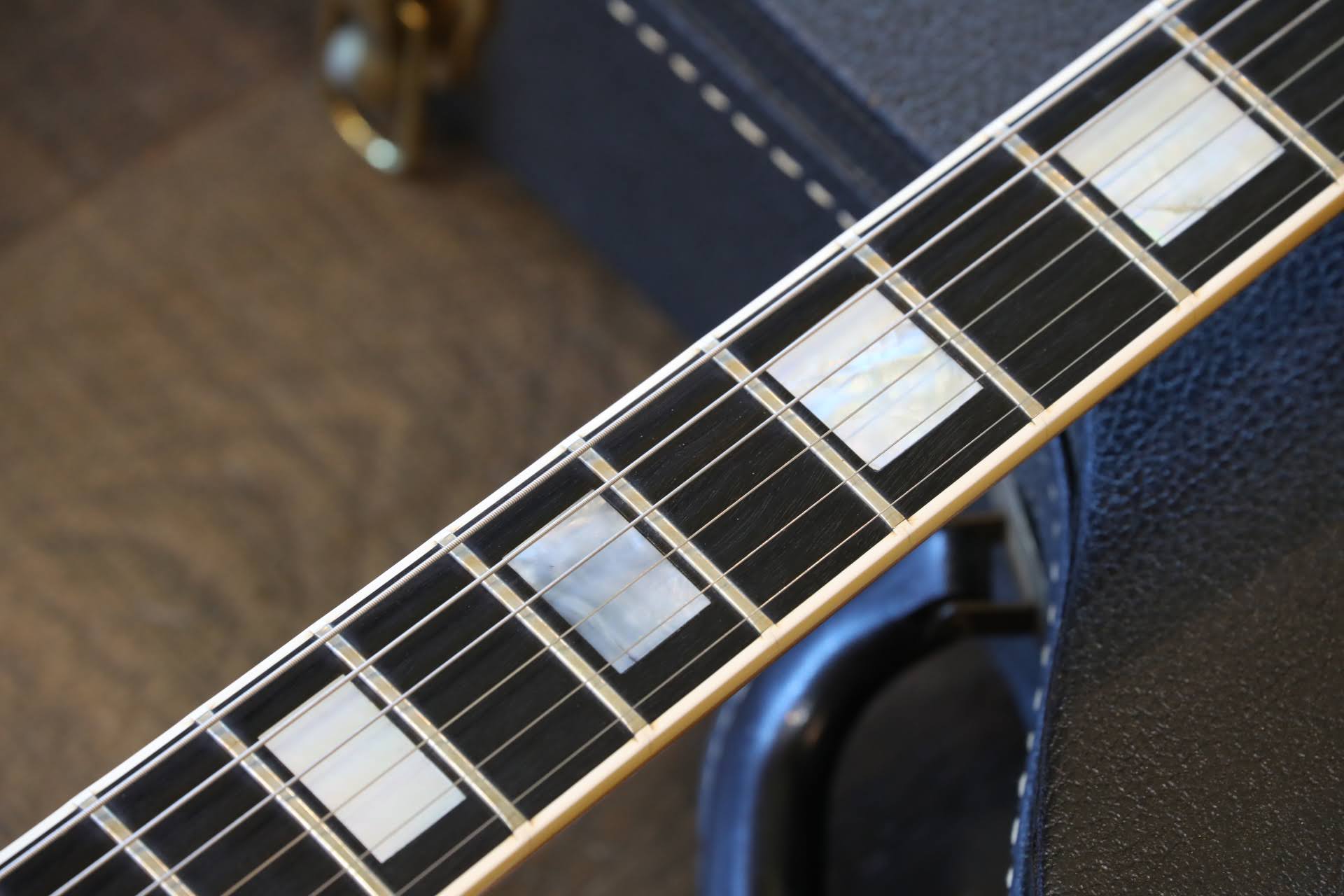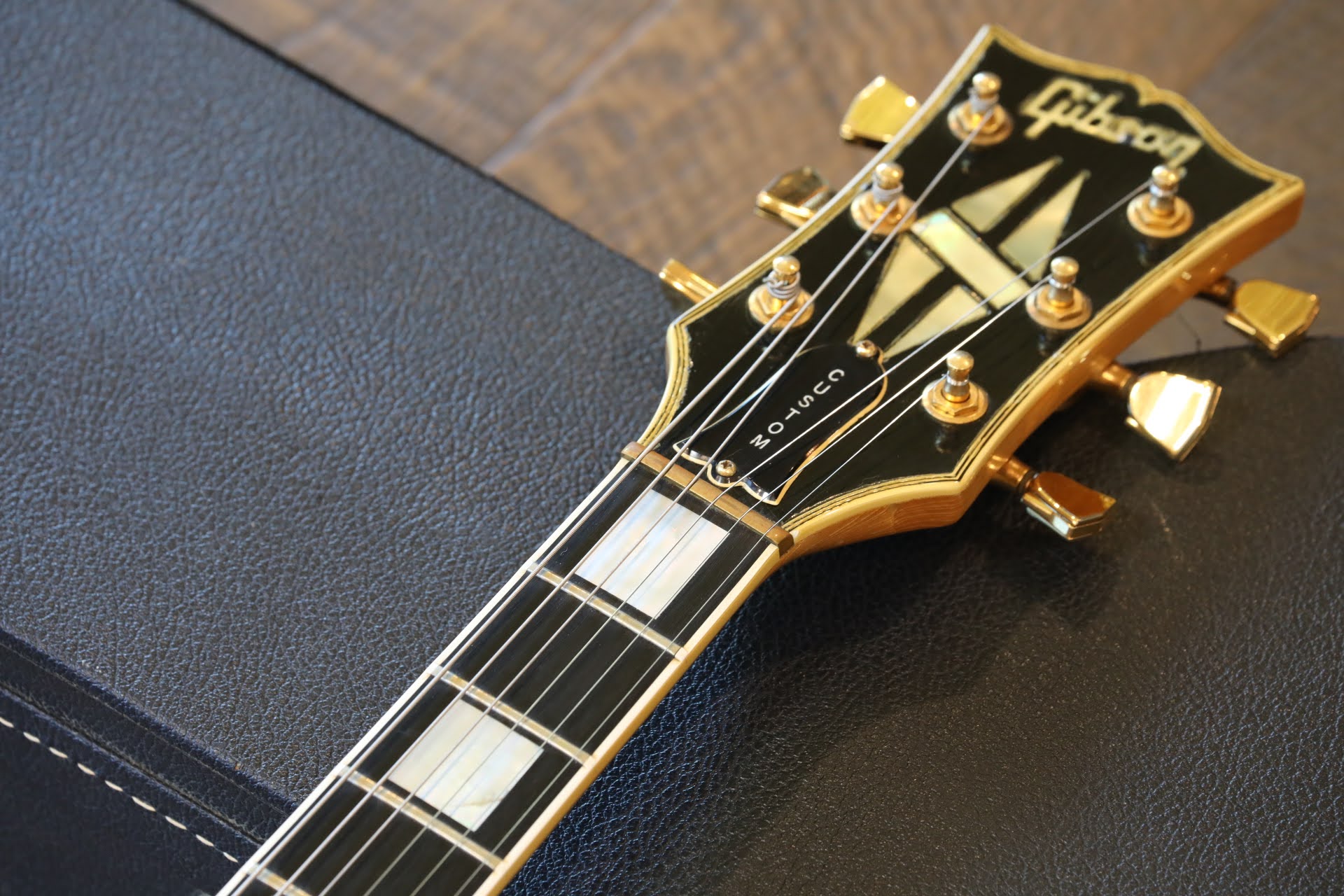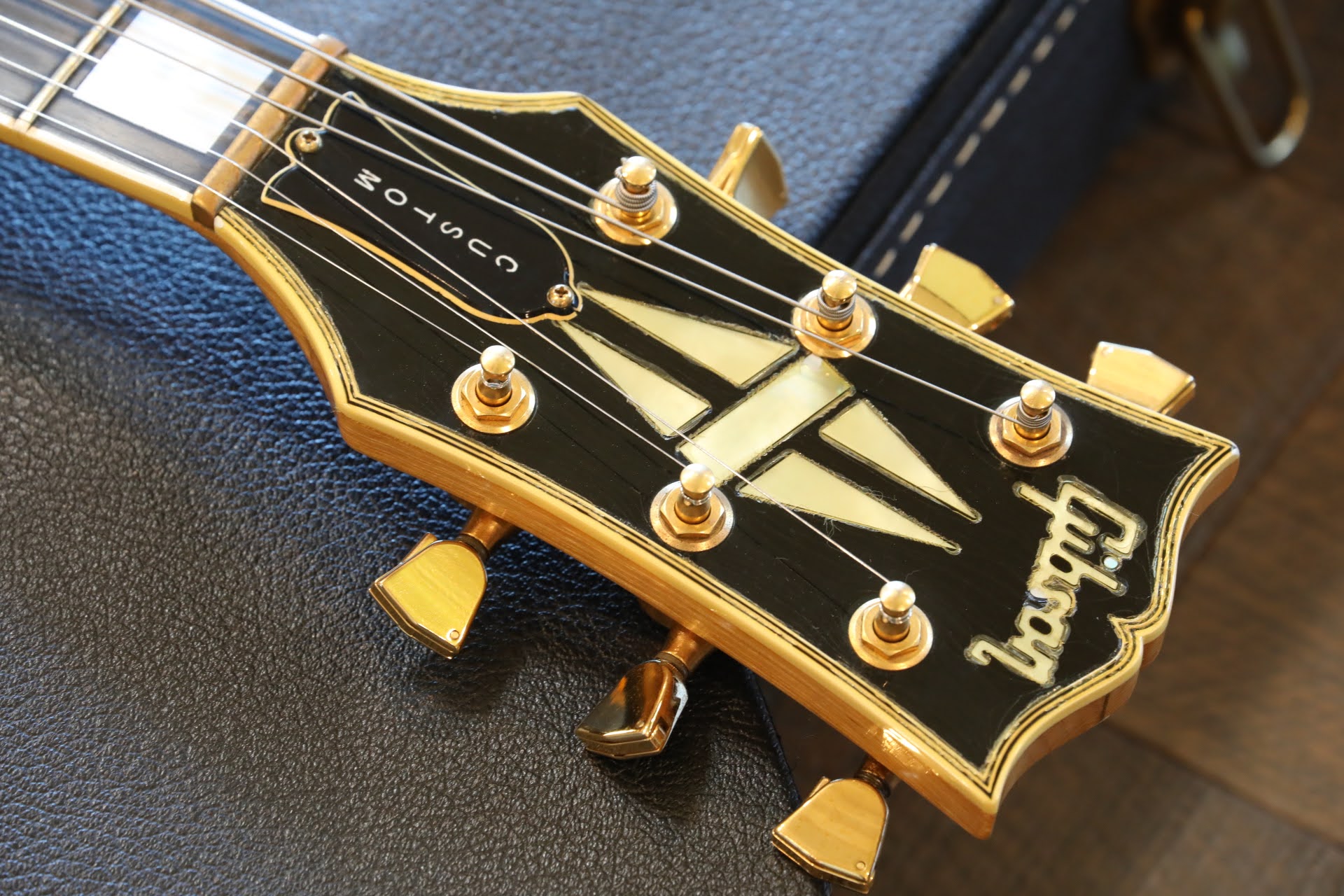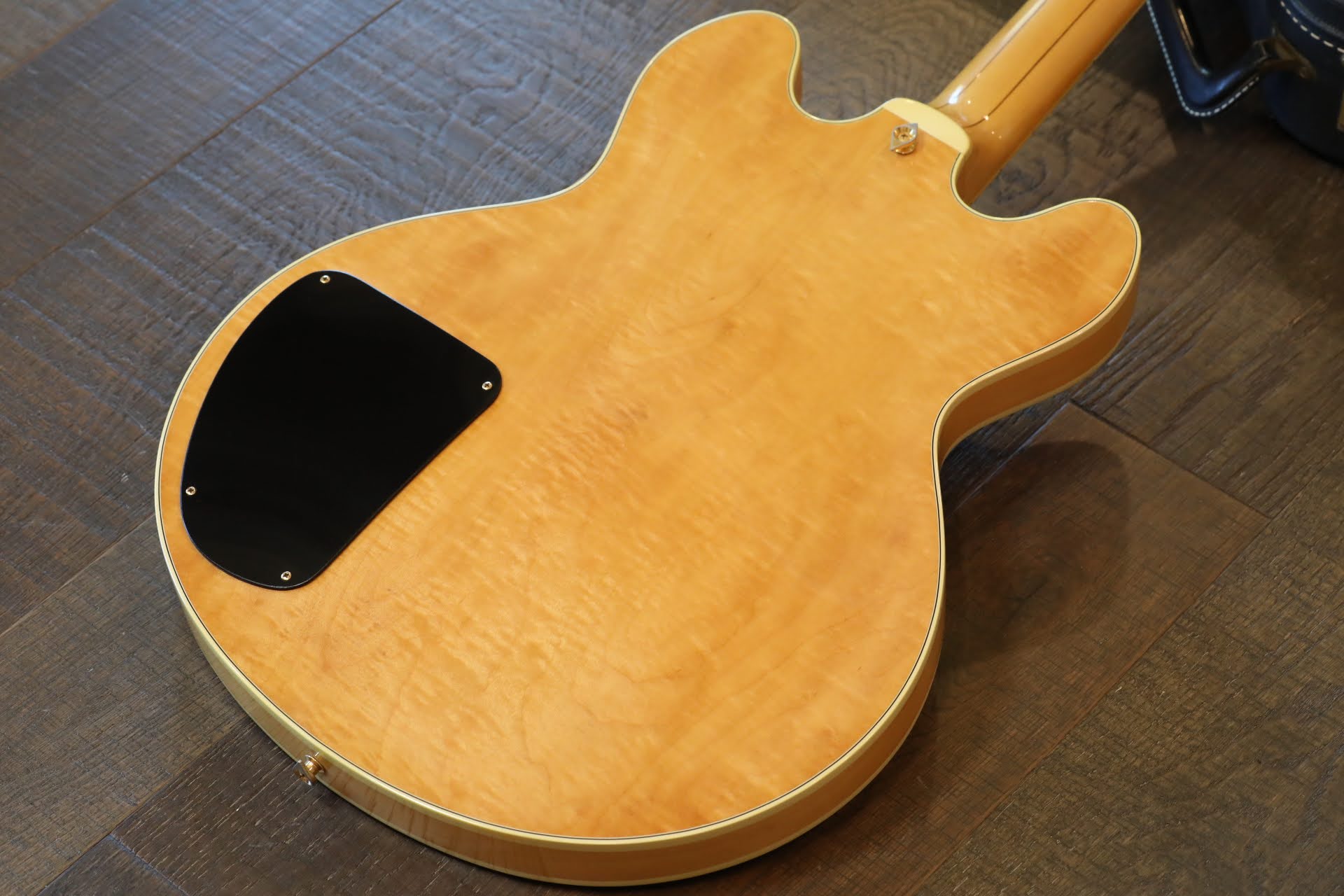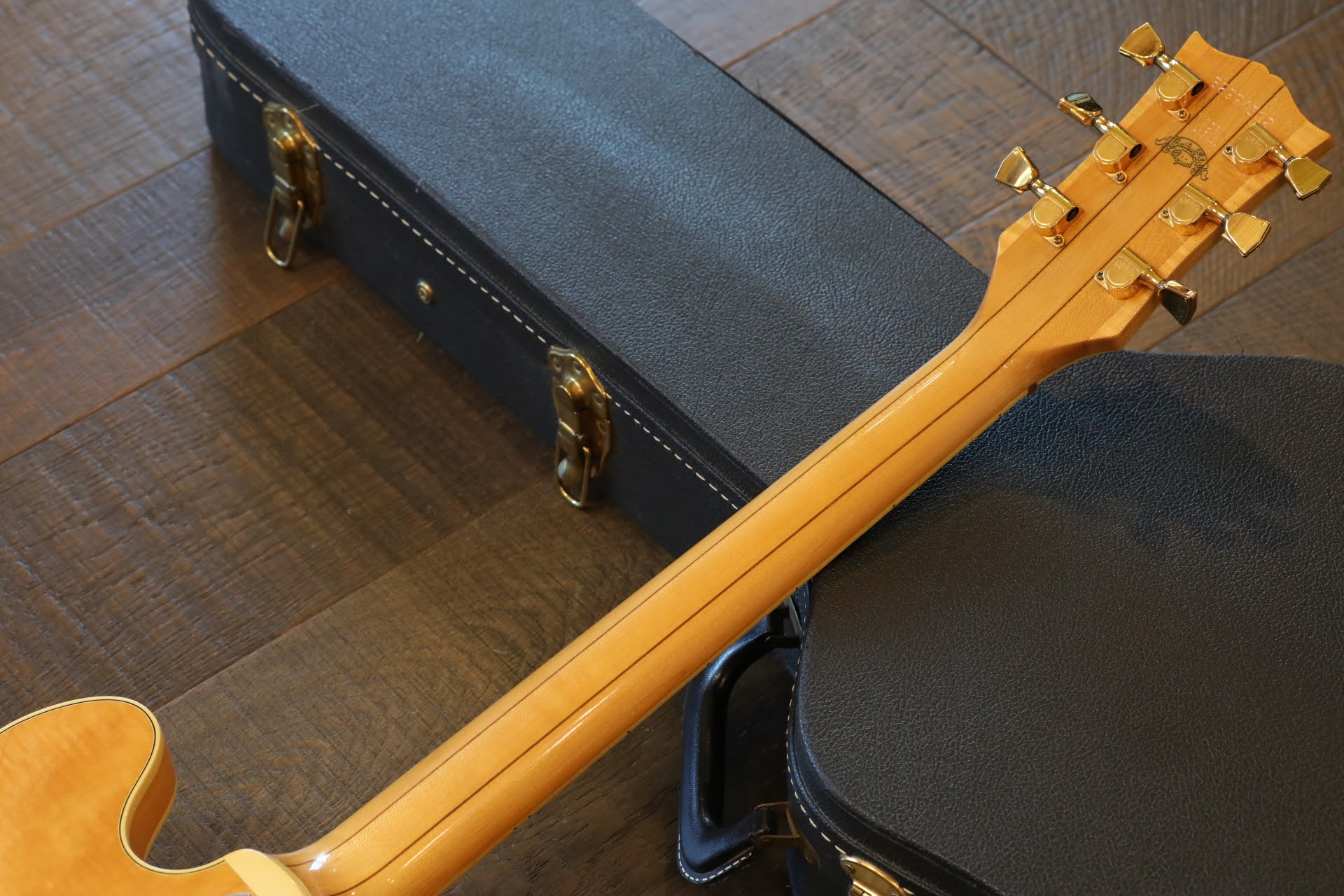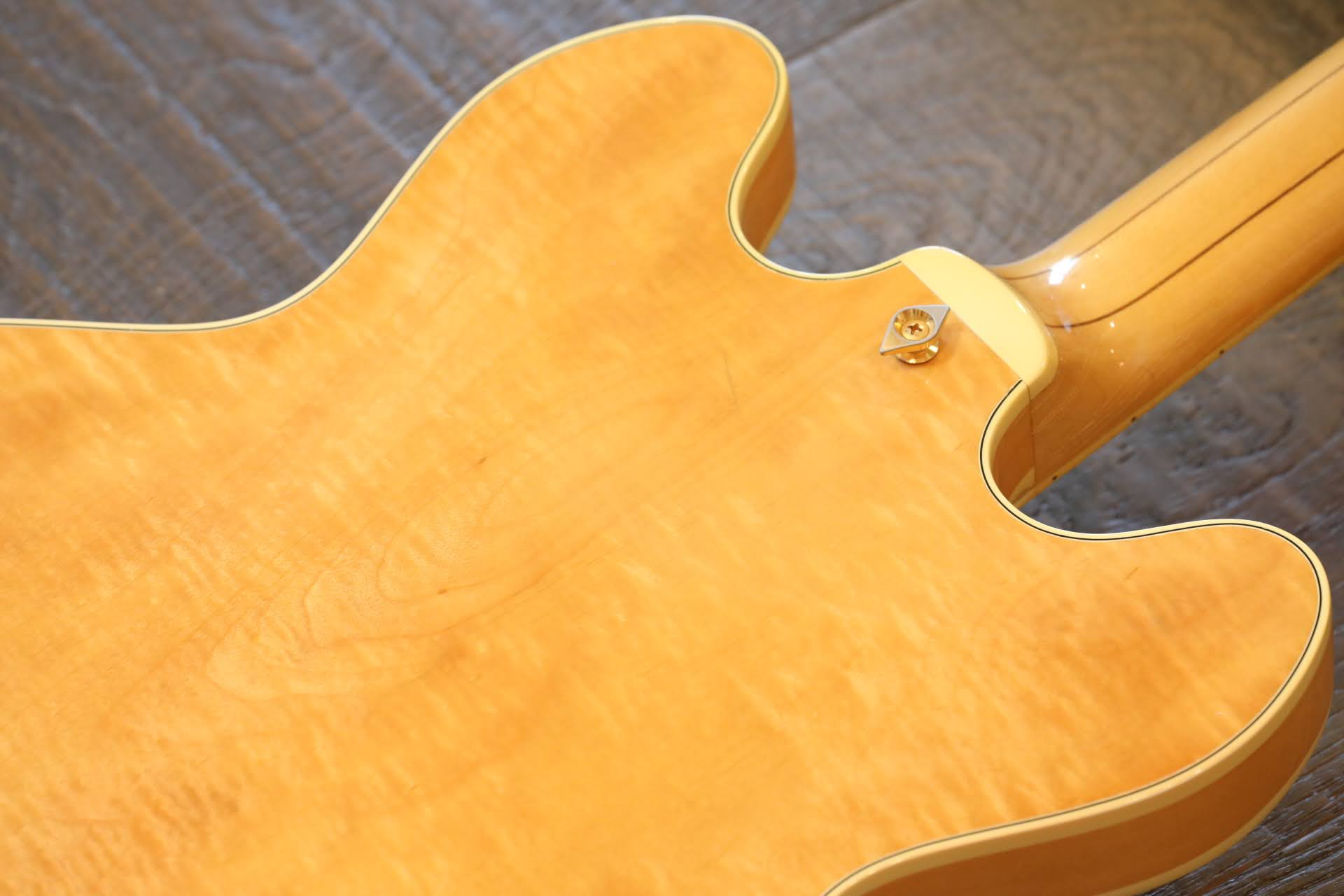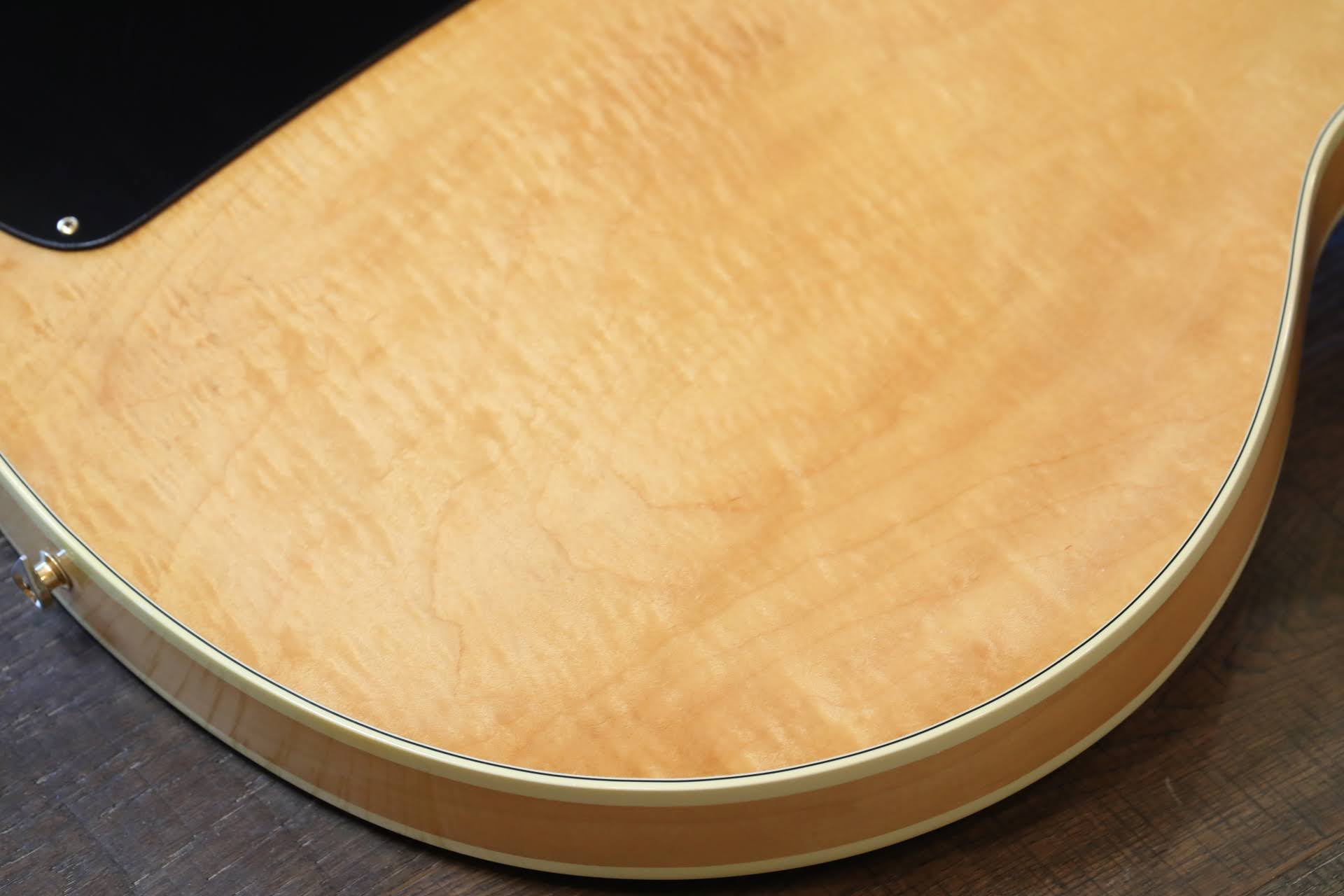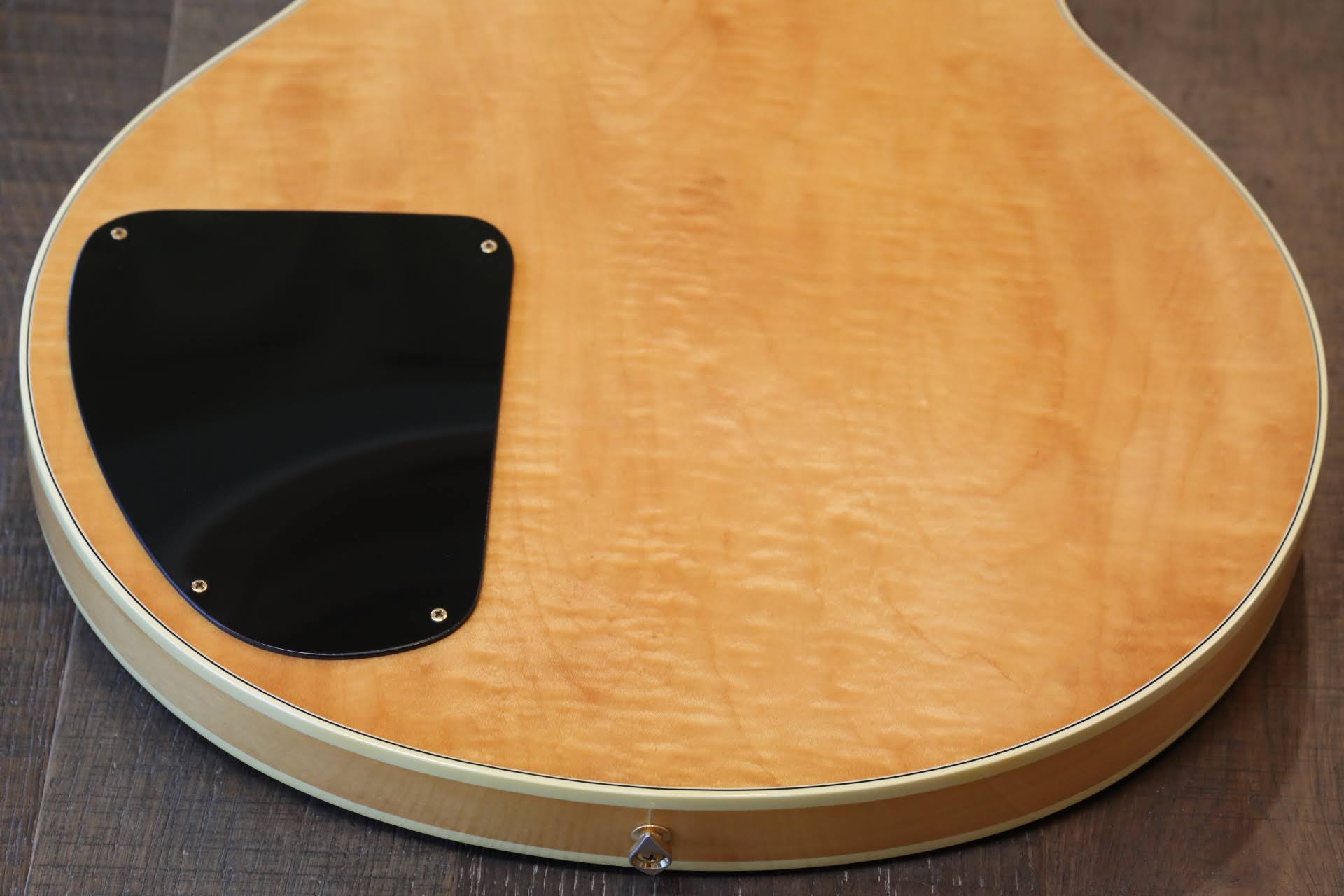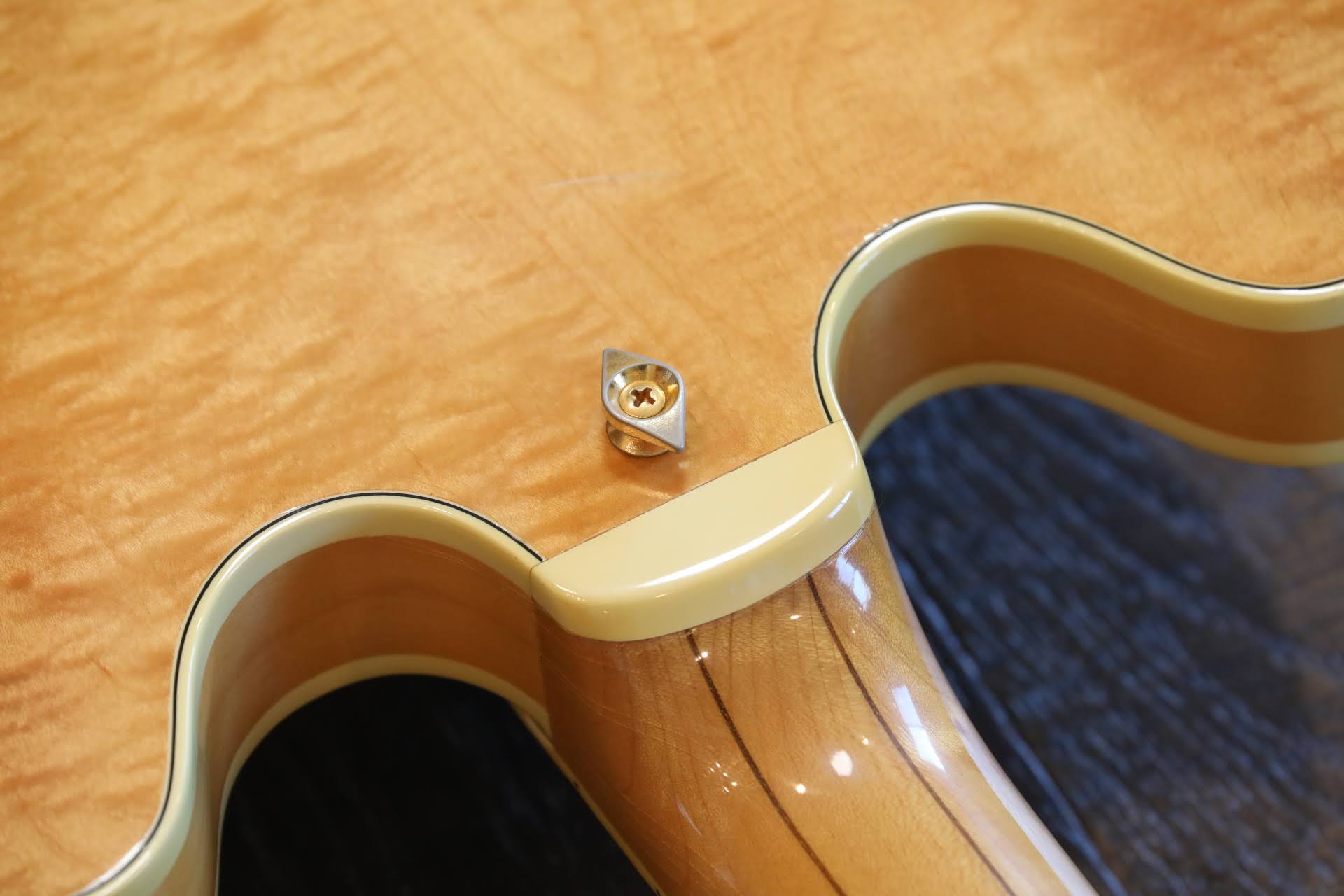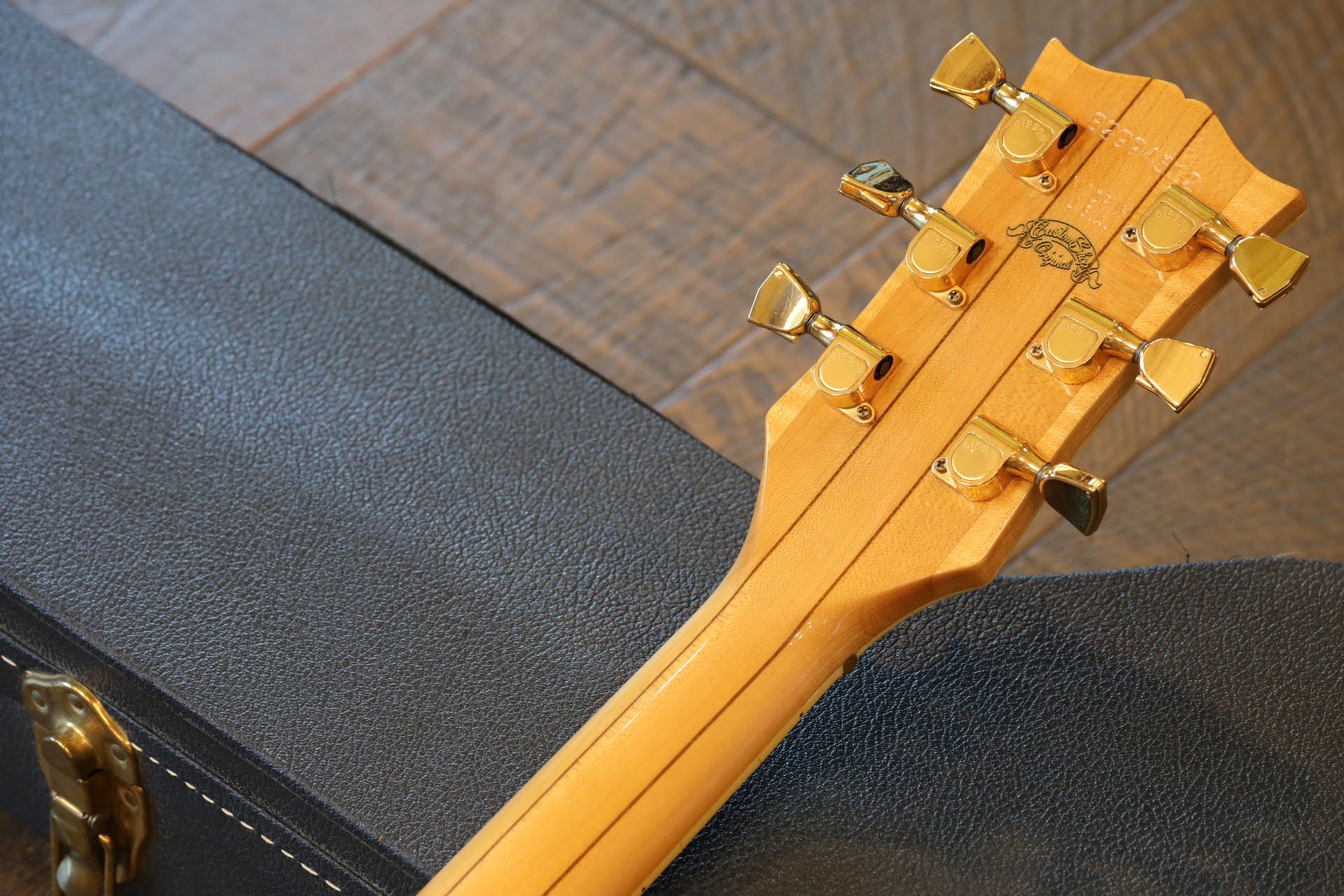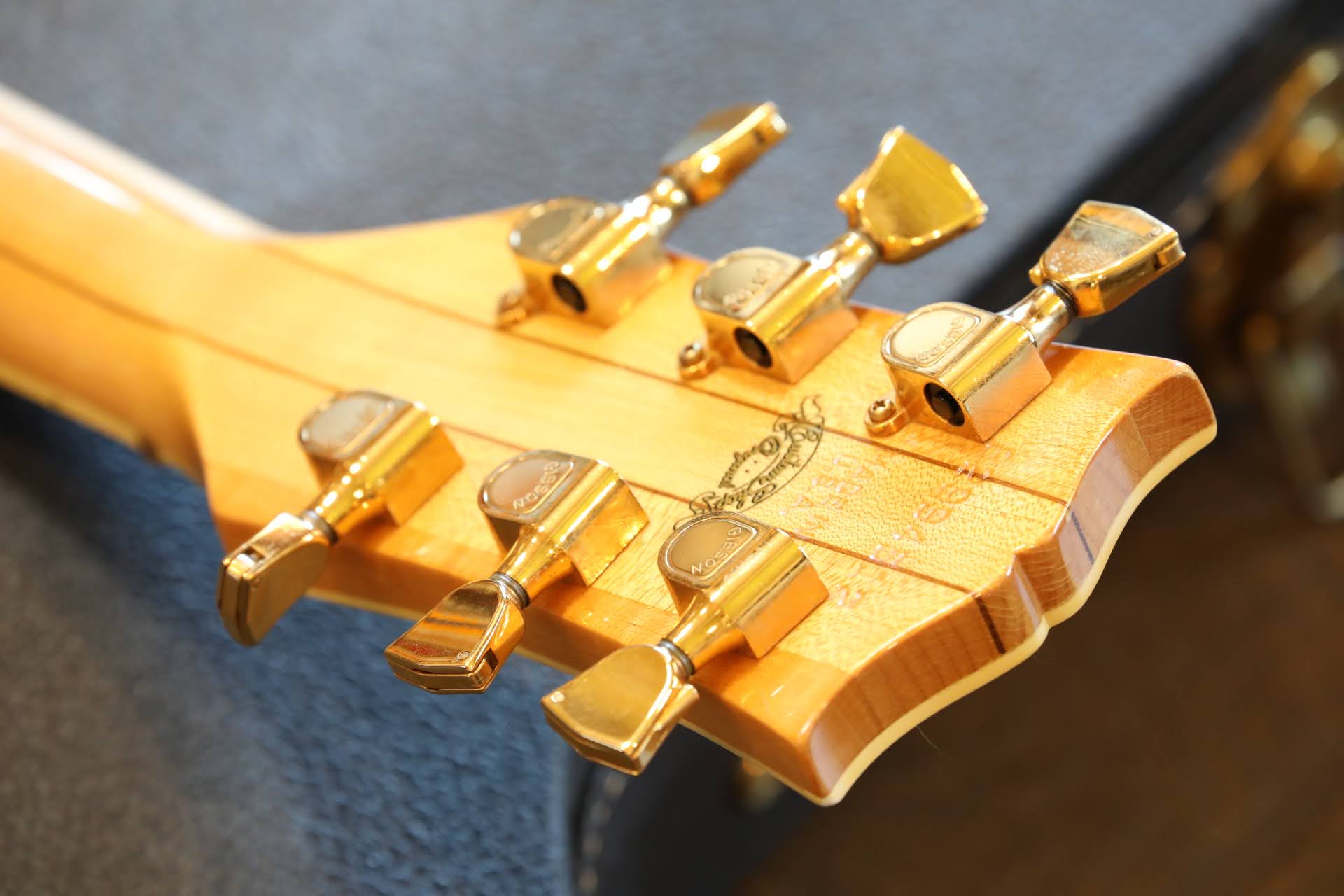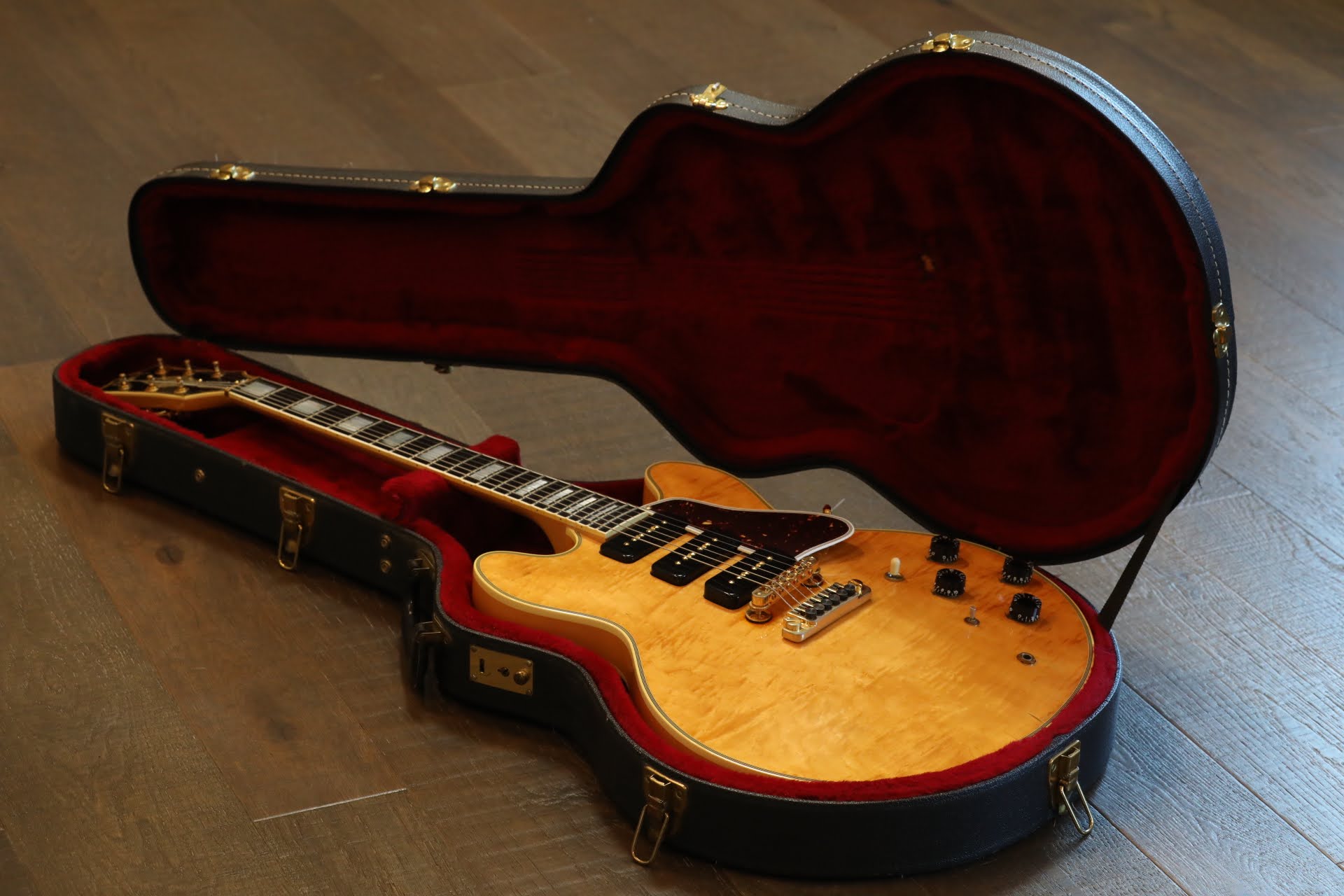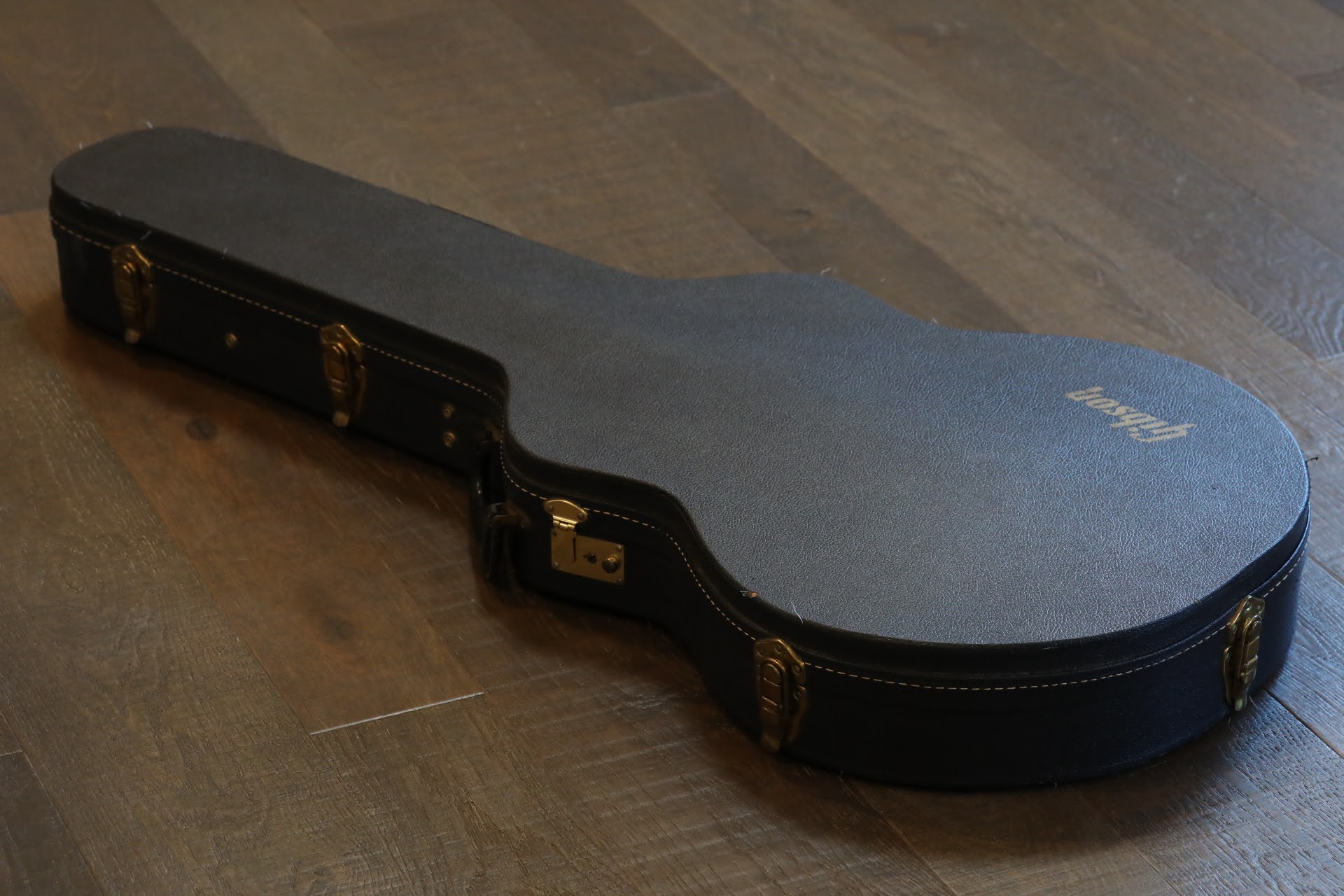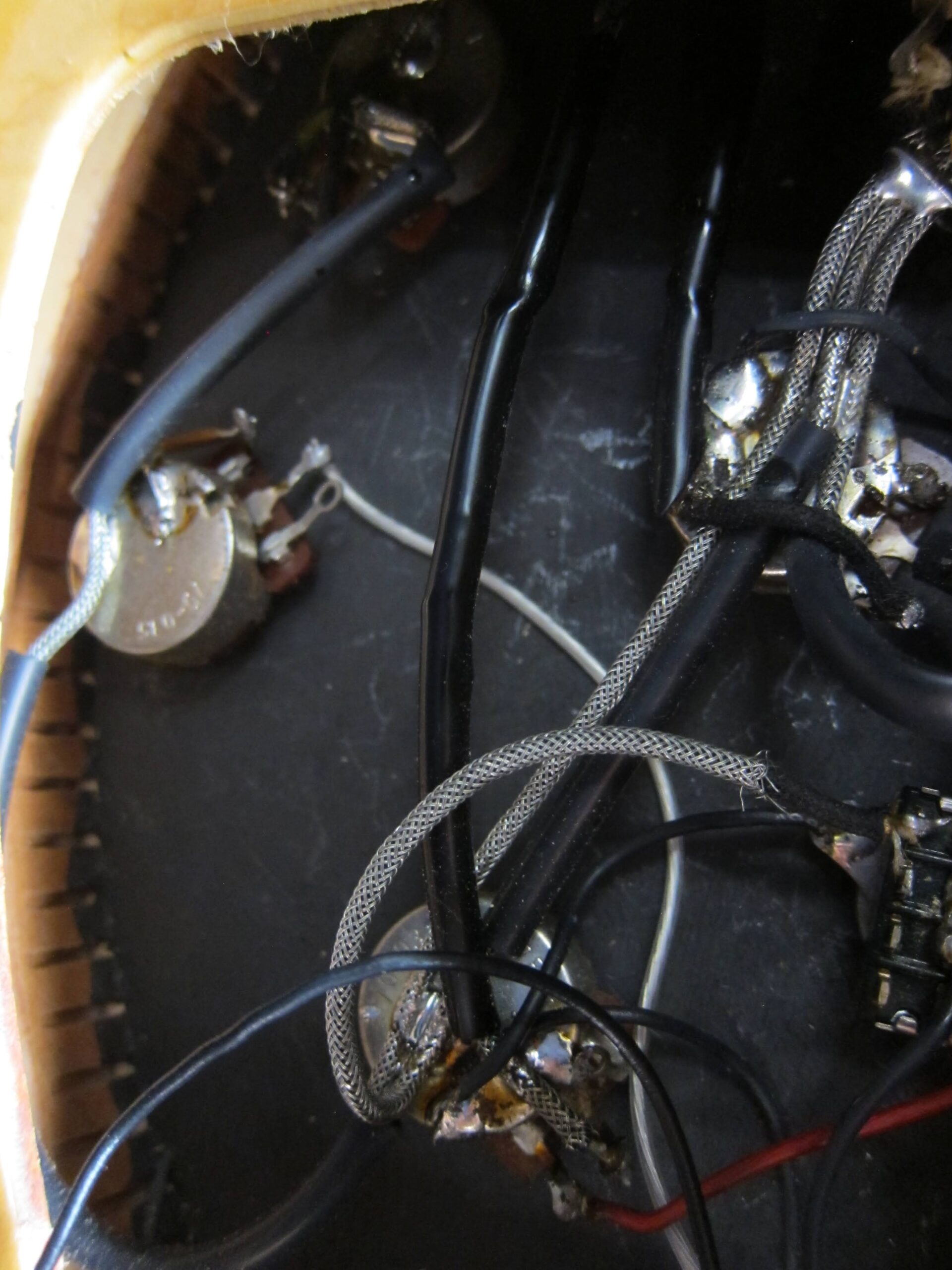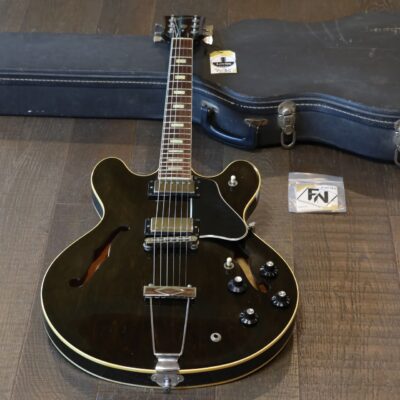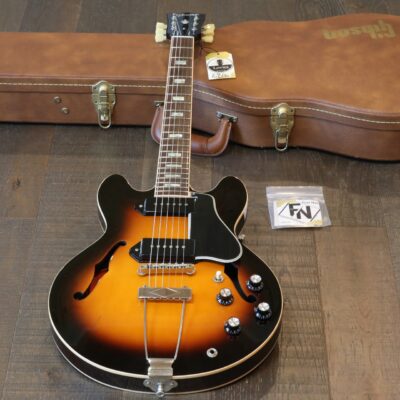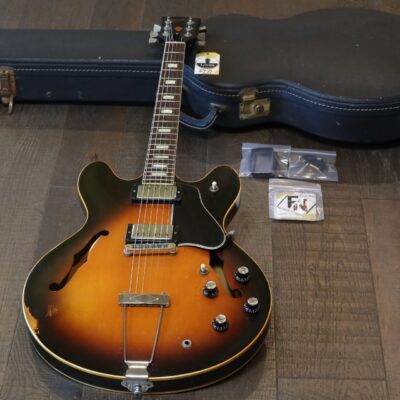Description
Lovies Guitars is Excited to offer up this 1984 Gibson ES-357 Figured Natural Semi-Hollow w/ 3 P90’s! In June of 1984 trucks came to take most of the machines out of Gibson’s historic Kalamazoo, Michigan factory and move them down to Nashville, Tennessee. The End of an Era. Shortly before, in May of ’84, the Gibson Custom Shop completed a batch of six instruments that had been co-designed by Los Angeles guitarist Mitch Holder in conjunction with Gibson R&D’s Tim Shaw and Bruce Bolen. These guitars were thin-line, semi-hollowbodies, made entirely of highly figured maple, with many deluxe, ES-355-style appointments, but with a number of interesting features that truly set them apart. They were two inches thick, not one-and-three-quarters. They had no F-holes. They had TP-6 fine-tuning tailpieces and graphite nuts. And they had three P-90 pickups with an easy-to-use switching system which allowed every possible combination available. Though never produced commercially, they were given a “model name” the ES-357 and over the next few years, a few more were built for customers by the Custom Shop in Nashville. Here’s the story behind these rare, unique, gorgeous, and historically significant guitars the last creations of Gibson’s Kalamazoo Custom Shop.
I was not aware of the ES-357′s existence myself until early ’96, when I had called Mitch Holder a noted session musician, ex-Tonight Show guitarist, and current Gibson Product Specialist (see separate article/ interview) to ask about his involvement in the development of Gibson’s ES-347 model. As we talked, I became a bit confused, until I realized we were discussing two completely different instruments. He was talking about an ES-357, something I’d never seen nor heard of. I was intrigued, so I pressed for details, and a wonderful journey of discovery began. Each new inquiry led to new informants, and enjoyable, educational and enlightening conversations with each new source led to new information and more guitars! My excitement really peaked when Mitch sent some snapshots of the “prototype” and his personal 357 he had never mentioned the jaw-dropping flamed maple! plus two photos of the almost completed “production” instruments, taken at the factory in Kalamazoo in May of 1984. Eureka!
In the mid-1970s, Mitch Holder was searching for a sound and, like a million guitarists before and since, searching for sustain. He was a part of the L.A. studio/jazz/fusion scene, and he and contemporaries like Larry Carlton, Lee Ritenour and Robben Ford had recently “rediscovered” the original, early, dot-inlay ES-335s, with stop tailpieces and Patent Applied For humbuckers. (Mitch says that there was a lot of one-upmanship among them “Listen! Mine sustains much more than yours!”). This was the Brass Age, as well, and people were experimenting with brass nuts, saddles and bridges for increased brightness and sustain. Wanting a guitar with such characteristics, and needing something fancier (having recently been hired by Doc Severinson’s Tonight Show band), Mitch ordered a bit of an experiment from Gibson. This ES-355 Custom has a three-piece maple neck, maple top, back and sides, an ebony fingerboard, gold hardware, and deluxe ES-355 trim, but with ES-335 electronics (mono, no Varitone), a brass nut, and most importantly, a Tunomatic bridge and stop tailpiece mounted directly into a large, solid brass block that is sunk into the instrument’s centerblock. Finished in a maroon or brick red, and delivered around June of ’76, this was the guitar Mitch used most on the Tonight Show and for session calls the next couple of years.
Gibson totally revamped its line of semi-hollowbody guitars (with the “wonder-thin silhouette”) in early 1979. They replaced the ES-335 with their first “reissue” the ES-335DOT and discontinued the ES-345 and 355, which had never sold as well as the more workmanlike 335. These guitars were replaced by a new model, the ES-347, which combined many of their most attractive features with new trends in guitar technology. The 347 had deluxe appointments: maple body and neck; bound ebony fingerboard with pearl block inlays; an SP-2 headstock with binding and tasteful “crown” inlay; and gold hardware. Its updated features included high-output “Dirty Fingers” humbuckers, a coil-tap switch, Gibson’s new TP-6 fine-tuning tailpiece, and the “Sustain Sisters”, which had their genesis in the big brass insert of Mitch Holder’s ES-355 Custom. Gibson R&D had refined Mitch’s concept, and the Sustain Sisters were four large, threaded brass inserts sunk into the centerblock, into which the TP-6 and Tunomatic bridge were mounted.
Mitch’s 355 Custom was, of course, extremely heavy, so he ordered a natural colored ES-347 when they came out. He says that “for some reason, I found that the blond ones sounded better (as did a few other session guys).” In the late 1970s the keyboard synthesizer was all the rage. Expensive, handmade synths with massive banks of analog circuitry and huge, complicated patch bays requiring an electrical engineering degree to program and play had given way to affordable, mass produced keyboards using digital microchip technology that were portable, versatile and easy to use. Producers loved them, and horn players and string sections found themselves being replaced by keyboard players. Mitch remembers a period, “around the time of the original Prophet 5″, when the L.A. session cats using two pickup, 335 type guitars were having trouble cutting through those reedy synth frequencies. “The scramble to find a guitar that would work started, and the Strat was it.” This may have contributed to the period’s rise in popularity of the Fender Stratocaster, which became the guitar of the ’80s. Mitch bought a 1963 Strat in 1977, but he was a lifelong lover of Gibson, with a predilection for archtops, and in the early ’80s he sought his own solution: a guitar that was to become the “prototype” ES-357.
Working with Gibson designers Tim Shaw and Bruce Bolen, Mitch says, “I got Gibson to build basically an ES-347 without F-holes (I had a feedback problem with my 347 and had to put sound ‘posts’ inside the body, like a violin, so I thought the lack of F-holes would help that…. It did.), and with three pickups. I had an ES-5 [1953, with P-90s, pre-Switchmaster] and loved the sound but didn’t like the lack of an easy switching system to access the various pickup combinations. Tim Shaw came up with the control scheme. It had three volume controls, [one] for each pickup, like the ES-5, and one master tone. Two toggles were used. One is a standard Gibson type [3-way pickup selector] and the other is a metal 3-position [mini] toggle that turns the middle pickup off [position 1] or on [position 2] in combination with the others and in the third position turns the middle pickup on by itself. It works really well and gets a unique sound somewhere between the ES-5 and pure Strat.”
Mitch referred to the pickups used on this instrument as “HP-90s”, so I called Tim Shaw for clarification. Tim was with Gibson from November 1979 to October 1992, in varying capacities, but mostly R&D and the Custom Shop during the Norlin years (before 1986), and remembers the prototype well. He had wound the pickups himself, with “maybe 10,000 turns of 43-gauge wire, instead of 42-gauge”. He cut off the ends of the bobbins so the pickups would fit inside a standard humbucker mount, with the rows of six adjustable pole-pieces in the centers of the covers. He did this in case Mitch wanted to change them later on. After all, who was using P-90s then? And all those Strat players were constantly battling single-coil squeal and hum.
The specs of this completed guitar, then, are as follows: a natural finished, double cutaway, thinline semi-hollowbody with figured maple top, back and sides, single-ply binding, and no F-holes. In Tim Shaw’s words, it has a “Les Paul Custom fingerboard [ebony with binding and pearl block inlays], three-piece maple 355 neck, and a J-200 headstock veneer [SP-2 shape with binding and a ‘Crown’ or ‘Holly’ inlay]“, all standard Gibson parts. The instrument has a brass nut, and the Tunomatic bridge and TP-6 tailpiece are mounted in Sustain Sisters. Tuning machines are Gibson’s deluxe, enclosed models with keystone-shaped pegs and built in string-winders. The electronics consist of three single-coil pickups that are housed under humbucking pickup covers within standard, black humbucker mounting rings. A master tone and three individual volume controls are in a standard Gibson trapezoidal array, with the regular pickup selector and a mini-toggle for the middle pickup located side by side, just below the bridge and behind the pickguard. All controls are in a shielded cavity, accessed through a removable back plate. Knobs are vintage-style brown “top hats”, the pickguard is “tortoise” with multiple layers of binding, and all hardware, including the pickup covers, is gold plated.
Tentatively called the ES-357, Mitch took delivery in 1983, and the guitar got a lot of use (episodes of “The Dukes of Hazzard”, “Night Rider”, and “Dallas”, and on records by Roberta Flack and Rita Coolidge, f’rinstance) and a lot of notice. It was a unique and gorgeous instrument that fulfilled its promise of useful versatility. Mitch says he “could see the many players who preferred the Gibson ‘feel’ leaning towards something like the 357″, but it “probably didn’t get put into regular production because of the financial woes going on at Gibson at that time.” Nevertheless, a number of notable West Coast guitarists Dennis Budimir, Tim May, Eddie Arkin, Jay Leach, and Joe Di Blasi all studio mainstays requested examples, so Mitch and Gibson’s R&D refined the design and the Kalamazoo Custom Shop began a batch of six ES-357s.
Eddie Arkin, who now does the music for “Melrose Place”, dubbed the 357 the “ES-Mitch”. In fact, everyone I called for information, when they heard “ES-357″, said “Oh, you mean the ‘ES-Mitch’?” The prototype was profiled, with photo, in a brief column titled “Mitch Holder’s Custom Gibson” in the June, 1984 Guitar Player, which also mentioned that Gibson was “issuing a half-dozen more of the models”.
These “production” guitars differed from Mitch’s prototype in a few different ways, many cosmetic. The soapbar pickups had standard, black plastic P-90 covers, with gold screws, and the bodies were given deluxe, 7-ply, white and black binding on top. The backs of the headstocks were finished in gloss black, like a top of the line L-5 or Super 400. “As the Kalamazoo plant was closing right after these guitars were made, they used the best looking maple they had left, probably to use it up”, says Mitch, noting that he’s “seen regular production models of that time with very flamed tops”, as well. A graphite nut was used instead of brass, “which, as we all found out, works a whole lot better.” The TP-6 tailpiece was moved closer to the bridge, for better tension, a change that was made on many production models around the same time. Although ordered with Sustain Sisters, Mitch says, “for some reason, they didn’t install them.” Conversation with Tim Shaw leads me to believe that it may have been an intentional oversight, for reasons of cost, time and ease of construction. In fact, it was shortly after that the Sustain Sisters were eliminated on production model ES-347s, as well. The ES-357s came with black “speed” knobs. Most significantly, the bodies were made two inches deep at their thinnest points, as opposed to the standard 13/4 inches, to give the instruments a bit more warmth, as the prototype was very bright sounding.
In May of 1984, Texas guitar aficionados Dr. Thomas Van Hoose (archtop authority and frequent VG contributor, researching his book on the Gibson Super 400) and Charley Wirz (of Charley’s Guitar Shop in Dallas, researching the history of Gibson’s thinline semi-hollowbodies) travelled to Kalamazoo to take a last-chance tour of the Gibson factory. Taken to the Custom Shop, they were shown a batch of fancy, blond guitars, each with three P-90s and no F-holes six of them. Most were in the racks, waiting for final set-up. Tom took a photo, and another of Charley holding a completed example. Charley Wirz, one of the first vintage dealers in America, passed away about six months later, his book unwritten. Years later, Mitch Holder was visiting Tom Van Hoose, and Tom showed him the snaps. Mitch recognized the guitar held by Charley as the one he’d later picked for himself.
In the summer of ’84, the ES-357s, which had been ordered on a special, six-piece deal, were shipped to Valley Arts Guitar Center in Studio City. Five bell-shaped, polished brass truss rod covers, each engraved with a guitarist’s name, were in a separate package. A sixth cover, inscribed “Jay Leach”, was already attached to one instrument, as his had been ordered with different neck specifications. Mitch Holder had first choice of the other five after all, it was the ES-Mitch so he took the guitars home and sat down with a friend, Steve Lukather, to try them out. The 357s had sequential serial numbers, the last three digits being 001 through 006. After Mitch and Luke had taken turns playing them all, comparing them to each other and the prototype, Mitch chose Number One. The other owners were summoned, and they descended on Mitch’s en masse, arriving to find the guitars arrayed on stands on either side of the prototype an impressive sight. Two of the six being spoken for, the remaining four notable cats sat down with the rest, passing pieces back and forth, playing and listening, searching for the one that felt and sounded best. Amazingly, says Mitch, “There were no fights”, and each player chose a different instrument for himself.
Mitch did, indeed, eventually change the outer two pickups on the prototype, to 490R neck and 498T bridge humbuckers, while keeping the original middle pickup. His other 357 he calls “#1″, and it now sports P-100 stacked humbuckers in front and back and a P-90 in the middle. He also changed the speed knobs, “to the antiqued top-hats like the prototype. I’m a knob freak. I’ve always liked the feel of the top-hat and reflector knobs of the ’50s and ’60s best.” Today, he says, “I use the prototype for most recording work, as it has a little brighter sound, and #1 for live gigs where I don’t need the brightness. They’re also set up a little different. On the prototype I use .010 gauge strings, and on #1, .011s.”
According to Mitch, all of the first 357s are still in their original owners’ hands, but prompted by their use, and the article in GP, Gibson took a few orders for ES-357 style guitars. There are some out there. One that surfaced recently built in Nashville in late 1984 and now owned by Danny Weber has ES-355 appointments (split-diamond headstock inlay), and a standard-depth body. This particular example does have Sustain Sisters, a brass nut, and the middle pickup’s control switch is in a different position. There’s also another totally cool variation on the theme that was built at the same time as the first six, a guitar dubbed the “ES-337″.
The 337 was built for Gibson’s Bruce Bolen by Tim Shaw. It has the 357′s three P-90s and control set-up, but the rest of the instrument is done pretty much to vintage 335 specs. It has F-holes. The one-piece mahogany neck is 1/32 of an inch wider than standard and has a bound ebony fingerboard with plain dot inlays. The hardware, including its ABR-1 model bridge and stop tailpiece, is all nickle plated. It’s finished in a vintage sunburst, and Tim gave it an Orange Label. He also purposely placed the plain black veneer a little off-center on the face of the SP-1 headstock, explaining that they wanted the guitar to “look like something Gibson could have done in the ‘old days’.” Bruce Bolen used the ES-337 for years at Gibson clinics and performances with B. B. King at trade shows and such. He sold it when he left Gibson. He recently said, “I’m not a collector, and I can only play one guitar at a time.” There’s only one ES-337, and it’s out there somewhere.
Mitch Holder thinks that “Gibson missed a real opportunity to keep the 335 style ‘current’ [with the ES-357], and probably would have built quite a few of them”, although “not necessarily with all the fancy stuff, for price considerations.” The 357 did successfully fill a need, getting both fat, Gibson tones and Fender Strat-like sounds, while maintaining a quality and character that are totally Gibson. Mitch says that if it were today, “I probably would have done it in a 3-pickup Nighthawk configuration.” Tim Shaw says that rumors surface from time to time around Nashville that such a thing might be on the drawing boards, tentatively titled the “Blues-hawk”. Tim says that the 357′s switching system was used on a camouflage-finished Explorer with three humbuckers, apparently built for promo purposes in the late ’80s.
The 357 is a beautiful and interesting sidelight in the history of Gibson’s ES-model guitars: a model that might have been. Of course, the story of the ES-357 took place mostly during very troubled times for Gibson the waning years of their even more troubled parent company, Norlin Industries. “The Black Years”, as they’re called by some. And then they closed the factory where the great innovations and guitars of the McCarty Era had been developed and built the birthplace of the thinline, semi-hollowbody, Electric Spanish guitar. Mitch says, “I remember talking to someone [there] on the phone just as the trucks came…. It wasn’t a particularly happy time for the folks who had been with Gibson in Kalamazoo for so many years.” Excellent Shape for its age! Has no real indents or scratches, finish checking from age and a few tiny indents, 9.8/10! ALL Original. NO Breaks, Cracks or Repairs. Includes an Original Hard-Shell Case and a Free Sample of Fret-Not, our favorite fretboard cleaner out there, check it out at fretnot.net!
WEIGHS in at: 9.45 lbs
1st Fret: .825”
12th Fret: .950”
Nut Width: 1 11/16”
Serial: 82994512
SKU: 6340
14 Day Money back return policy. Buy with confidence.
All guitars are GUARANTEED to arrive in described condition for full refund will be issued. All guitars are fully insured and we will deal with any claims.
Lovies Guitars has CITES Master File and Certificates will be issued when and where needed. Also Declaration Friendly.

